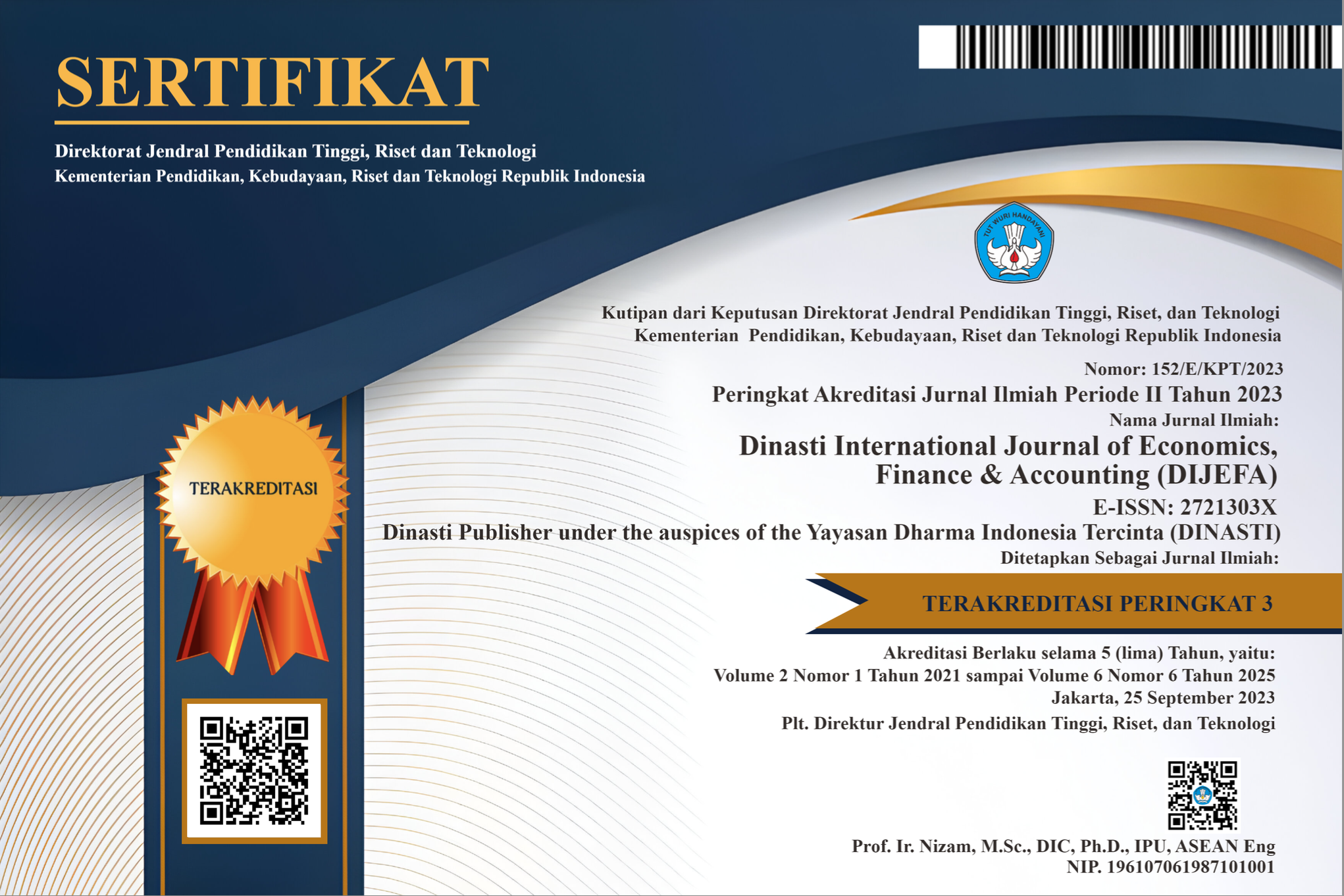Online Loan Fraud Cases in Indonesia: Diamond Fraud Dimensions
DOI:
https://doi.org/10.38035/dijefa.v5i3.2806Keywords:
Fraud, Online Loans, Diamond Fraud, Cases in Indonesia.Abstract
The purpose of this paper is to show fraud under the guise of online loans that harm the community and provide solutions so that people avoid these scams. In the Online Loan program, many people have complained about the dissemination of personal data to the authorities that have been carried out by the Online Loan organizer without prior notification from the party concerned. The use of data used in this paper comes from journal articles and also online news related to fraud cases under the guise of online loans that occur in Indonesia. The main factor in the rise of illegal online loans (Pinjol) is the unfulfilled needs and strong belief in money. The Financial Services Authority (OJK) said that the level of financial literacy and inclusion in the peer-to-peer financial technology (fintech P2P) technology industry or online loans (pinjol) is still relatively low. The results stated that it is necessary to implement stricter regulations, increase transparency, build a centralized database to track fraudulent activities, strengthen consumer protection laws, and provide legal solutions for fraud victims. With a comprehensive and coordinated approach, it is expected to reduce fraud cases in online loan services and increase public trust in this industry.
References
Abekah Koomson, T. A., & Yaw Owusu, G. M. (2022). The Motivation to Engage in Fraud by Individuals at the Workplace. Delivering Distinctive Value in Emerging Economies: Efficient and Sustainably Responsible Perspectives from Management Researchers and Practitioners, 189–204. https://doi.org/10.4324/9781003152217-17
Anggraeni, R. (2023). OJK Beri Bukti Kontribusi Pinjol pada Ekonomi Indonesia 2023. Retrieved April 12, 2024, from https://finansial.bisnis.com/read/20230921/563/1697302/ojk-beri-bukti-kontribusi-pinjol-pada-ekonomi-indonesia-2023
Angkasa, A., Wamafma, F., Juanda, O., & Nunna, B. P. (2023). Illegal Online Loans in Indonesia: Between the Law Enforcement and Protection of Victim. In Lex Scientia Law Review (Vol. 7). https://doi.org/10.15294/lesrev.v7i1.67558
Anindya, J. R., & Adhariani, D. (2019). Fraud risk factors and tendency to commit fraud: analysis of employees’ perceptions. International Journal of Ethics and Systems, 35(4), 545–557. https://doi.org/10.1108/IJOES-03-2019-0057
Annur, C. M. (2023). Ada 3,9 Ribu Aduan Kasus Pinjol Ilegal sejak Awal 2023, Ini Tren Bulanannya. Retrieved April 12, 2024, from https://databoks.katadata.co.id/datapublish/2023/06/14/ada-39-ribu-aduan-kasus-pinjol-ilegal-sejak-awal-2023-ini-tren-bulanannya
Arief, W. A. I. dan M. A. B. (2023). The Influence of Fraud Hexagon Perspective on Fraud Financial Statement (Case studies on Manufacturing in the Chemical and Basic Industries Sub-Sector Listed on the Indonesia Stock Exchange for the Period 2019-2021). 4072–4081. https://doi.org/10.46254/AP03.20220656
Awalluddin, M. A., Tuan Nooriani, T. I., & Maznorbalia, A. S. (2022). The Relationship Between Perceived Pressure, Perceived Opportunity, Perceived Rationalization And Fraud Tendency Among Employees: A Study From The People’s Trust In Malaysia. Studies in Business and Economics, 17(2), 23–43. https://doi.org/10.2478/SBE-2022-0023
Benamati, J. H., Ozdemir, Z. D., & Smith, H. J. (2017). An empirical test of an Antecedents - Privacy Concerns - Outcomes model. Journal of Information Science, 43(5), 583–600. https://doi.org/10.1177/0165551516653590
Bertsch, C., Hull, I., Qi, Y., & Zhang, X. (2020). Bank misconduct and online lending. Journal of Banking and Finance, 116. https://doi.org/10.1016/J.JBANKFIN.2020.105822
Cressey, D. R. (Donald R. (1973). Other people’s money; a study in the social psychology of embezzlement. 191. Retrieved from https://search.worldcat.org/title/628437
Daniel, L., Mediaty, M., & Ibrahim, M. A. (2024). Pengaruh Skeptisisme Profesional dan Integritas terhadap Kemampuan Auditor dalam Mendeteksi Kecurangan. Akrual: Jurnal Bisnis Dan Akuntansi Kontemporer, 19–31. https://doi.org/10.26487/AKRUAL.V17I01.28365
de Gardelle, V., & Mamassian, P. (2014). Does confidence use a common currency across two visual tasks? Psychological Science, 25(6), 1286–1288. https://doi.org/10.1177/0956797614528956
Dewi, H. K. (2020). Begini Peran Fintech dalam Pemulihan Ekonomi Nasional. Retrieved April 13, 2024, from https://www.bareksa.com/berita/berita-ekonomi-terkini/2020-11-09/begini-peran-fintech-dalam-pemulihan-ekonomi-nasional
Dian Oktarina. (2022). Social Media Sebagai Data Non Financial Untuk Deteksi Financial Fraud. Accounting and Management Journal, 6(1), 26–35. https://doi.org/10.33086/AMJ.V6I1.2733
Dimitrijevi?, D., & Jovanovi?, D. (2022). Economic Motives and Willingness of Young People to Participate in Fraud. Naše Gospodarstvo/Our Economy, 68(3), 18–27. https://doi.org/10.2478/NGOE-2022-0015
Frik, A., & Mittone, L. (2019). Factors Influencing the Perception of Website Privacy Trustworthiness and Users’ Purchasing Intentions: The Behavioral Economics Perspective. Journal of Theoretical and Applied Electronic Commerce Research, 14(3), 89–125. https://doi.org/10.4067/S0718-18762019000300107
Gannett, A., & Rector, C. (2015). The Rationalization of Political Corruption. Public Integrity, 17(2), 165–175. https://doi.org/10.1080/10999922.2015.1000654
Ge, X. (2023). Analysis of legal framework solutions to protect retail consumers. International Journal of Retail and Distribution Management. https://doi.org/10.1108/IJRDM-02-2023-0055
Ginting, G. (2023). Analysis and Assessment of Legal Protection of The Community and Online Loan Debtors During The Covid 19 Pandemic. 1(04), 277–282. https://doi.org/10.58451/ijebss.v1i04.44
Harmon, L. W., Borgen, F. H., Berreth, J. M., King, J. C., Schauer, D., & Ward, C. C. (1996). The skills confidence inventory: A measure of self-efficacy. Journal of Career Assessment, 4(4), 457–477. https://doi.org/10.1177/106907279600400408
Hayu Dwimawanti, I., & Ramadani, N. (2023). The Fraud Diamond of Public Service in Indonesia. KnE Social Sciences. https://doi.org/10.18502/KSS.V8I11.13569
He, J., & Li, Q. (2020). Can online social interaction improve the digital finance participation of rural households? China Agricultural Economic Review, 12(2), 295–313. https://doi.org/10.1108/CAER-11-2019-0213
Hidayah, N., & Sholiqin, M. N. (2023). Pengaruh Fraud Diamond Terhadap Perilaku Kecurangan Akademik Mahasiswa dengan Dua Faktor Moderasi. Akuntansi?: Jurnal Akuntansi Integratif, 8(2), 163–173. https://doi.org/10.29080/JAI.V8I2.833
Huang, R. H. (2018). Online P2P Lending and Regulatory Responses in China: Opportunities and Challenges. European Business Organization Law Review, 19(1), 63–92. https://doi.org/10.1007/S40804-018-0100-Z
J, D. Ks. Bi. P. (2022). Faktor-Faktor yang Mempengaruhi Kemampuan Auditor dalam mendeteksi Kecurangan: pendekatan Explanatori Sequential.
Jahari, S. A., Hass, A., Hass, D., & Joseph, M. (2022). Navigating privacy concerns through societal benefits: A case of digital contact tracing applications. Journal of Consumer Behaviour, 21(3), 625–638. https://doi.org/10.1002/CB.2029
Januraga, P. P., & Harjana, N. P. A. (2020). Improving Public Access to COVID-19 Pandemic Data in Indonesia for Better Public Health Response. Frontiers in Public Health, 8, 563150. https://doi.org/10.3389/FPUBH.2020.563150
Kamalludin, I., Suhendar, H., Pratami, B. D., Yaqin, ’Alamul, & Afifah, N. (2022). Criminal law treats for online gambling performers: investment fraud modes. Dialogia Iuridica, 14(1), 26–51. https://doi.org/10.28932/di.v14i1.5252
Kankam, P. K. (2020). Approaches in Information Research. New Review of Academic Librarianship, 26(1), 165–183. https://doi.org/10.1080/13614533.2019.1632216
Kassem, R. (2022). How could external auditors assess the rationalization of fraud? Journal of Financial Crime, 29(4), 1458–1467. https://doi.org/10.1108/JFC-08-2021-0184
Kaur, S., & Arora, S. (2021). Role of perceived risk in online banking and its impact on behavioral intention: trust as a moderator. Journal of Asia Business Studies, 15(1), 1–30. https://doi.org/10.1108/JABS-08-2019-0252
Knisley, R. J., & Lin, H. (2022). A Review of Literature and Experimental Evidence on Fraud Motivation: Differentiating Incentive and Pressure. Journal of Forensic Accounting Research, 7(1), 184–209. https://doi.org/10.2308/JFAR-2020-024
Kurniawati, H., & Yunanto, Y. (2022). Perlindungan Hukum Terhadap Penyalahgunaan Data Pribadi Debitur Dalam Aktivitas Pinjaman Online. Jurnal Ius Constituendum, 7(1), 102. https://doi.org/10.26623/jic.v7i1.4290
Laurin, K., & Jettinghoff, W. M. (2020). What kind of rationalization is system justification? The Behavioral and Brain Sciences, 43, e39. https://doi.org/10.1017/S0140525X19002243
Libaque-Saenz, C. F., Chang, Y., Kim, J., Park, M. C., & Rho, J. J. (2016). The role of perceived information practices on consumers’ intention to authorise secondary use of personal data. Behaviour and Information Technology, 35(5), 339–356. https://doi.org/10.1080/0144929X.2015.1128973
Lubis, M., Saputra, M., & Nurtrisha, W. A. (2021). Financial Technology Development Framework for Prosperity of the Nation and Potential Direction. https://doi.org/10.1145/3479162.3479194
Luna, K., & Martín-Luengo, B. (2012). Confidence-Accuracy Calibration with General Knowledge and Eyewitness Memory Cued Recall Questions. Applied Cognitive Psychology, 26(2), 289–295. https://doi.org/10.1002/ACP.1822
Mabsuti, M., & Nurtresna, R. (2022). Perlindungan hukum terhadap konsumen pinjaman oline dalam sistem hukum indonesia. Bureaucracy Journal?: Indonesia Journal of Law and Social-Political Governance, 2(1), 235–243. https://doi.org/10.53363/bureau.v2i1.90
Made, K. A., Cahyaningsih, D. S., & Djati, W. (2023). Fraud Diamond: Four Elements of Financial Report Fraud Detection – Study on Coal Producers. Journal of Research on Business and Tourism, 3(1), 55. https://doi.org/10.37535/104003120236
Maghfirah, F., & Husna, F. (2022). Cyber Crime and Privacy Right Violation Cases of Online Loans in Indonesia. PROCEEDINGS: Dirundeng International Conference on Islamic Studies, 1–18. https://doi.org/10.47498/dicis.v1i1.1009
Mashatan, A., Sangari, M. S., & Dehghani, M. (2022). How Perceptions of Information Privacy and Security Impact Consumer Trust in Crypto-Payment: An Empirical Study. IEEE Access, 10, 69441–69454. https://doi.org/10.1109/ACCESS.2022.3186786
Meifaliani Putri, F., & Fadilah, S. (2023). Analisis Faktor–Faktor Fraud Diamond dan Ukuran Perusahaan terhadap Kecurangan Laporan Keuangan pada Perusahaan Sub Sektor Transportasi yang Terdaftar di Bursa Efek Indonesia Periode 2019-2021. Bandung Conference Series: Accountancy, 3(1). https://doi.org/10.29313/BCSA.V3I1.6061
Milne, G. R., Pettinico, G., Hajjat, F. M., & Markos, E. (2017). Information Sensitivity Typology: Mapping the Degree and Type of Risk Consumers Perceive in Personal Data Sharing. Journal of Consumer Affairs, 51(1), 133–161. https://doi.org/10.1111/JOCA.12111
Mirza Gayatri, A., & Muzdalifah, M. (2022). Memahami Literasi Keuangan sebagai upaya Pencegahan Perilaku Konsumtif dari Pinjaman Online. Judicious, 3(2), 297–306. https://doi.org/10.37010/jdc.v3i2.1113
Moroke, N. D., & Makatjane, K. (2022). Predictive modelling for financial fraud detection using data analytics: A gradient-boosting decision tree. Applications of Machine Learning and Deep Learning for Privacy and Cybersecurity, 25–45. https://doi.org/10.4018/978-1-7998-9430-8.CH002
Murphy, P. R., & Dacin, M. T. (2011). Psychological Pathways to Fraud: Understanding and Preventing Fraud in Organizations. Journal of Business Ethics, 101(4), 601–618. https://doi.org/10.1007/S10551-011-0741-0
Nadia, N., Nugraha, N., & Sartono, S. (2023). Analisis Pengaruh Fraud Diamond Terhadap Kecurangan Laporan Keuangan Pada Bank Umum Syariah. Jurnal Akuntansi Dan Governance, 3(2), 125. https://doi.org/10.24853/JAGO.3.2.125-139
Natalia, L., Fadilla, N. N., Umar, A., Arief, M., & Widyaningsih, A. (2022). Analysis of Factors Affecting the Auditor’s Ability to Detect Fraud. International Journal Management Science and Business Journal, 4(1), 45–66. https://doi.org/10.17509/msb.v5i1
Nurcahya Ningsih, I. (2023). Criminal Accountability For Illegal Online Loans That Conduct Crime In The Form Of Peer-To-Peer Lending In The Community. Article 368 Awang Long Law Review, 5(2), 397–404.
Omar, M., Nawawi, A., & Salin, A. S. A. P. (2016). The causes, impact and prevention of employee fraud: A case study of an automotive company. Journal of Financial Crime, 23(4), 1012–1027. https://doi.org/10.1108/JFC-04-2015-0020
Ong, A. S. J. (2018). Perpetrators vs. Auditors: Factors that Influence the Occurrence of Fraud and Audit Interventions. https://doi.org/10.33915/ETD.7223
Pallier, G., Wilkinson, R., Danthiir, V., Kleitman, S., Knezevic, G., Stankov, L., & Roberts, R. D. (2002). The role of individual differences in the accuracy of confidence judgments. Journal of General Psychology, 129(3), 257–299. https://doi.org/10.1080/00221300209602099
Pleasence, P., & Balmer, N. J. (2019). Development of a General Legal Confidence Scale: A First Implementation of the Rasch Measurement Model in Empirical Legal Studies. Journal of Empirical Legal Studies, 16(1), 143–174. https://doi.org/10.1111/JELS.12212
Pratiwi, R., Prabowo, M. S., Nugroho, M., & Wardhani, W. N. R. (2022). Fraud Risk in Peer Lending Fintech Transactions: The Role of Consumer Protection Regulation in Indonesia. International Journal of Social Science and Business, 6(4), 469–477. https://doi.org/10.23887/IJSSB.V6I4.46511
Purnaningsih, N. K. C. (2022). Fraudulent Financial Reporting Analysis on Non-Financial Companies Listed on IDX in Hexagon Fraud Perspective. Budapest International Research and Critics Institute (BIRCI-Journal). https://doi.org/10.33258/BIRCI.V5I2.4955
Putri, P. A., & Rinaldi, K. (2023). The problems of Illegal Online Loans based on the Victim’s Perspective: A Case Study. International Journal of Advances in Social and Economics, 4(3), 102–106. https://doi.org/10.33122/ijase.v4i3.215
Qi, M., Cui, J., Li, X., & Han, Y. (2021). Perceived factors influencing the public intention to use E-Consultation: Analysis of web-based survey data. Journal of Medical Internet Research, 23(1). https://doi.org/10.2196/21834
Rinaldo, N. S. M., Oktavia, R., & Amelia, Y. (2022). Fraud Triangle Perspective on The Tendency of Fraudulent Financial Statements in Non-financial State-Owned Enterprises. Asian Journal of Economics and Business Management, 1(2), 58–66. https://doi.org/10.53402/AJEBM.V1I2.86
Rodrigues, C. C. C. (2022). “No One Treated it as a Crime”: An Empirical Study of Corruption Rationalization. Academy of Management Proceedings, 2022(1). https://doi.org/10.5465/AMBPP.2022.11697ABSTRACT
Rushton, P. W., Miller, W. C., Kirby, R. L., & Janice, J. (2013). Measure for the ass essment of confidence wit h manua l wheelchair use (wheelcon-m) version 2.1: Relia bility and validity. Journal of Rehabilitation Medicine, 45(1), 61–67. https://doi.org/10.2340/16501977-1069
Rustam, M. H., Hamler, H., Marlina, T., Handoko, D., & Alamsyah, R. (2023). Peran Dan Tanggung Jawab Konsumen Untuk Mencegah Praktik Penipuan Dalam Transaksi Online Dari Perspektif Hukum Perlindungan Konsumen. Riau Law Journal, 7(1), 1. https://doi.org/10.30652/rlj.v7i1.8050
Sergeyev, A. Y., & Shirokova, O. (2023). Fraud in a digital society in the context of social change. ???????? ??????????, 6(1), 59–71. https://doi.org/10.26425/2658-347x-2023-6-1-59-71
Setiawan, M. A. (2019). The Influence of Pressure in Detecting Financial Statement Fraud. https://doi.org/10.2991/ICAME-18.2019.47
Shalahuddin, A Tegar, & Yunita, A. (2022). Perlindungan Hukum Terhadap Pengguna Pinjaman Online Ilegal (Studi di Otoritas Jasa Keuangan Wilayah Yogyakarta). JCH Jurnal Cendikia Hukum, 8(September), 118–138. https://doi.org/10.3376/jch.v8i1.583
Smith, A. M., & Leach, A. M. (2019). Confidence Can Be Used to Discriminate Between Accurate and Inaccurate Lie Decisions. Perspectives on Psychological Science, 14(6), 1062–1071. https://doi.org/10.1177/1745691619863431
Stewart, E. A. (2023). Research methods. How Britain Loves the NHS, 121–127. https://doi.org/10.51952/9781447368892.BM001
Stewart, J., O’Halloran, C., Barton, J. R., Singleton, S. J., Harrigan, P., & Spencer, J. (2000). Clarifying the concepts of confidence and competence to produce appropriate self-evaluation measurement scales. Medical Education, 34(11), 903–909. https://doi.org/10.1046/J.1365-2923.2000.00728.X
Subagiyo, D. T., Gestora, L. R., & Sulistiyo, S. (2022). Characteristic of illegal online loans in indonesia. Indonesia Private Law Review, 3(1), 69–84. https://doi.org/10.25041/iplr.v3i1.2594
Sulistianingsih. (2023). Greed, Opportunity Pemicu Fraud Dengan Moderasi Idealisme Pimpinan. JRAK (Jurnal Riset Akuntansi Dan Bisnis), 9(1), 234–243. https://doi.org/10.38204/JRAK.V9I1.1141
Sun, X., & Chen, Y. (2022). Why do people with similar levels of internal control differ in their likelihood to commit fraud? Analysis of the moderating effect of perceived opportunity to commit fraud. Frontiers in Psychology, 13. https://doi.org/10.3389/FPSYG.2022.999469/PDF
Vogt, R. L., Zheng, A., Briley, D. A., Malanchini, M., Harden, K. P., & Tucker-Drob, E. M. (2022). Genetic and Environmental Factors of Non-Ability-Based Confidence. Social Psychological and Personality Science, 13(3), 734–746. https://doi.org/10.1177/19485506211036610
Wang, Cheng, Zhu, H., Hu, R., Li, R., & Jiang, C. (2023). LongArms: Fraud Prediction in Online Lending Services Using Sparse Knowledge Graph. IEEE Transactions on Big Data, 9(2), 758–772. https://doi.org/10.1109/TBDATA.2022.3172060
Wang, Chenyang. (2022). Online Dating Scam Victims Psychological Impact Analysis. Journal of Education, Humanities and Social Sciences, 4, 149–154. https://doi.org/10.54097/ehss.v4i.2740
Wang, P., Zheng, H., Chen, D., & Ding, L. (2015). Exploring the critical factors influencing online lending intentions. Financial Innovation, 1(1). https://doi.org/10.1186/S40854-015-0010-9
Wolfe, D. T., & Hermanson, D. R. (2004a). The Fraud Diamond: Considering the Four Elements of Fraud. Retrieved from https://digitalcommons.kennesaw.edu/facpubs
Wolfe, D. T., & Hermanson, D. R. (2004b). The FWolfe, D. T. and Hermanson, D. R. (2004) ‘The Fraud Diamond?: Considering the Four Elements of Fraud: Certified Public Accountant’, The CPA Journal, 74(12), pp. 38–42. doi: DOI:raud Diamond?: Considering the Four ElemWolfe, D. T. and Hermanson, D. R. The CPA Journal, 74(12), 38–42.
Wulandari, H. K. (2019). Faktor-Faktor Internal yang Mempengaruhi Kemampuan Auditor dalam Mendeteksi Kecurangan (Fraud) (Studi Empiris pada Bpk RI Perwakilan Provinsi Jawa Tengah) - Neliti. Retrieved April 13, 2024, from https://www.neliti.com/publications/331084/faktor-faktor-internal-yang-mempengaruhi-kemampuan-auditor-dalam-mendeteksi-kecu
Xu, J. J., Chen, D., Chau, M., Li, L., & Zheng, H. (2022). Peer-to-Peer Loan Fraud Detection: Constructing Features from Transaction Data. MIS Quarterly, 46(3), 1777–1792. https://doi.org/10.25300/MISQ/2022/16103
Yuniasih, N., Muliati, N., Putra, C., & Dewi, I. (2020). The Effect of Pressure to Financial Statement Fraud (Study of Manufacturing Companies Listed on The Indonesian Stock Exchange). https://doi.org/10.4108/EAI.13-8-2019.2294390
Zhang, Z., & Ye, Z. (2022). The role of social-psychological factors of victimity on victimization of online fraud in China. Frontiers in Psychology, 13(December), 1–10. https://doi.org/10.3389/fpsyg.2022.1030670
Zhao, S., Huang, Y., Chen, L., Wang, C., Li, S., Chen, L., & Pan, G. (2023). Loan Fraud Users Detection in Online Lending Leveraging Multiple Data Views. Proceedings of the 37th AAAI Conference on Artificial Intelligence, AAAI 2023, 37, 5428–5436. https://doi.org/10.1609/aaai.v37i4.25675
Downloads
Published
How to Cite
Issue
Section
License
Copyright (c) 2024 Junaidi Junaidi, Endraria Endraria

This work is licensed under a Creative Commons Attribution 4.0 International License.
Authors who publish their manuscripts in this journal agree to the following conditions:
- The copyright on each article belongs to the author(s).
- The author acknowledges that the Dinasti International Journal of Economics, Finance & Accounting (DIJEFA) has the right to be the first to publish with a Creative Commons Attribution 4.0 International license (Attribution 4.0 International (CC BY 4.0).
- Authors can submit articles separately, arrange for the non-exclusive distribution of manuscripts that have been published in this journal into other versions (e.g., sent to the author's institutional repository, publication into books, etc.), by acknowledging that the manuscript has been published for the first time in the Dinasti International Journal of Economics, Finance & Accounting (DIJEFA).


























































